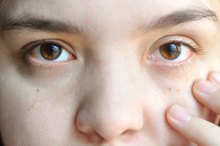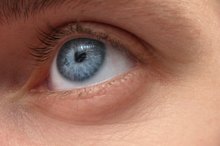Cold in the Eye Symptoms
Many people experience eye symptoms toward the end of or just after a head cold. This condition is aptly termed a "cold in the eye" because it typically represents spread of the virus responsible for the cold spreading to the eye. This condition, a form of pink eye or viral conjunctivitis, most frequently occurs due to infection with adenovirus -- a common culprit for head colds and the leading cause of viral conjunctivitis. Symptoms of a cold in the eye are uncomfortable but typically clear on their own without specific treatment.
Eye Redness
With a cold in the eye, a virus infects the conjunctiva -- the thin membrane of tissue that lines the eyelids and covers the front of the eyeball. The infection irritates this tissue, causing redness of the whites of the eyes. If you look closely, you'll typically see thin squiggly red lines, which represent tiny dilated blood vessels. The inside and rims of the eyelids also typically appear red.
- With a cold in the eye, a virus infects the conjunctiva -- the thin membrane of tissue that lines the eyelids and covers the front of the eyeball.
- If you look closely, you'll typically see thin squiggly red lines, which represent tiny dilated blood vessels.
Lid Swelling
Causes of White Eye Discharge
Learn More
Viral infection of the conjunctiva provokes an inflammatory response by the immune system, which almost always leads to eyelid swelling. Most people experience only mild to moderate swelling, but significant puffiness can occur with severe cases. Eyelid swelling is usually most pronounced when waking up in the morning, and often diminishes when cool compresses are applied to the eyes.
Eye Discharge
Viral conjunctivitis related to a cold typically provokes a watery discharge from the eyes. Many people with a cold in the eye notice some mild crusting on the eyelids or whitish discharge in the corners of the eyes after sleeping. This material can be removed with a damp, warm washcloth. Holding the washcloth on eyelid crusts for a few minutes loosens them so they can be wiped away without further eyelid irritation. Throw the washcloth in the laundry immediately after use to avoid spreading the infection to others in your household.
- Viral conjunctivitis related to a cold typically provokes a watery discharge from the eyes.
- Many people with a cold in the eye notice some mild crusting on the eyelids or whitish discharge in the corners of the eyes after sleeping.
Eye Burning and Itching
Inflamed Eye Membrane Causes
Learn More
Many people with viral conjunctivitis experience a persistent burning or itching sensation in the eyes. Eye cold sufferers should avoid rubbing their eyes since this can further irritate the eyes and may lead to spreading the condition to others. Refrigerated artificial tears may provide short-term relief. Severe cases of viral conjunctivitis can trigger a sensation as if something is in the eye, a symptom doctors refer to as a foreign body sensation.
- Many people with viral conjunctivitis experience a persistent burning or itching sensation in the eyes.
- Severe cases of viral conjunctivitis can trigger a sensation as if something is in the eye, a symptom doctors refer to as a foreign body sensation.
Other Possible Symptoms
People with a cold in the eye sometimes experience swelling and tenderness of the lymph nodes in front of the ears. These nodes swell as part of the immune system's response to the infection. More severe cases of viral conjunctivitis can cause light sensitivity, or photophobia. Uncommonly, blurry vision develops with a cold in the eye. This occurs when the viral infection extends from the conjunctiva into the cornea, the clear tissue beneath the conjunctiva at the front of the eye. People who have corneal involvement may notice halos around lights.
- People with a cold in the eye sometimes experience swelling and tenderness of the lymph nodes in front of the ears.
- More severe cases of viral conjunctivitis can cause light sensitivity, or photophobia.
Warnings and Precautions
Viral conjunctivitis due to a cold typically goes away within 7 to 14 days 1. There is no specific treatment for this condition, but comfort measures can help reduce uncomfortable symptoms. See your doctor if your eye symptoms persist for longer than 2 weeks, or are severe or worsening. Many eye conditions cause symptoms similar to a cold in the eye, some of which are serious and require immediate treatment. See your doctor as soon as possible if you experience any warning signs or symptoms, including: -- thick yellow or green eye discharge -- pain in or behind the eyeball -- unequal or distorted pupils -- diminished or cloudy vision -- rash near the eye or on the eyelid
Reviewed and revised by: Tina M. St. John, M.D.
- Viral conjunctivitis due to a cold typically goes away within 7 to 14 days 1.
- See your doctor if your eye symptoms persist for longer than 2 weeks, or are severe or worsening.
Related Articles
References
- Merck Manual Professional Version: Viral Conjunctivitis
- Centers for Disease Control and Prevention: Adenoviruses
- American Family Physician: Diagnosis and Management of Red Eye in Primary Care
- Optometry Times: How to Manage Adenoviral Conjunctivitis
- Centers for Disease Control and Prevention. Conjunctivitis (Pink Eye): Causes. Updated January 4, 2019.
- Meyer-rüsenberg B, Loderstädt U, Richard G, Kaulfers PM, Gesser C. Epidemic keratoconjunctivitis: the current situation and recommendations for prevention and treatment. Dtsch Arztebl Int. 2011;108(27):475-80. doi:10.3238/arztebl.2011.0475
- National Eye Institute. Facts About Pink Eye. Updated November 2015.
- Azher, T.; Yin, X.; Tajfirouz, D. et al. Herpes simplex keratitis: challenges in diagnosis and clinical management. Clin Ophthalmol. 2017; 11:185-91. doi:10.2147/OPTH.S80475
- Goodman, D.; Rogers, J.; and Livingston, E. Conjunctivitis. JAMA. 2013; 309(20):2176. doi:10.1001/jama.2013.4432
- Palafox S.; Jasper, S.; Tauber, A. et al. Ophthalmia Neonatorum. J Clinic Experiment Ophthalmol. 2011; 2:119. doiI:10.4172/2155-9570.1000119.
- National Eye Institute. Cornea | Giant Papillary Conjunctivitis (GPC).
- Zikic A, Schünemann H, Wi T, Lincetto O, Broutet N, Santesso N. Treatment of Neonatal Chlamydial Conjunctivitis: A Systematic Review and Meta-analysis. J Pediatric Infect Dis Soc. 2018;7(3):e107-e115. doi:10.1093/jpids/piy060
Writer Bio
Kate Beck started writing for online publications in 2005. She worked as a certified ophthalmic technician for 10 years before returning to school to earn a Masters of Fine Arts degree in writing. Beck is currently putting the finishing touches on a novel.









